It’s hard to pin down a favorite embroidery stitch, isn’t it?
But I’m pretty sure most of us must have favorites – those stitches we return to, time and time again, and that always perform well for us. The stitches that are comfortable and easy to be with, like good friends.
While I like many embroidery stitches, there are really only a handful that I’d call “Absolute Favorite Stitches,” and the fishbone stitch is right up around the top of that list.
Perhaps I like it so much because I stitch a lot of petals and leaves and similar shapes, and it just works so darned well in those circumstances! In fact, I’m willing to stick my neck out and say that, when it comes to petal and leaf shapes, the fishbone stitch is The Best. It’s where it’s at, if you want a nice looking leaf!
But there are other reasons I like it, too.
If you haven’t familiarized yourself with the fishbone stitch, here’s a little encouragement for you to try it and use it.
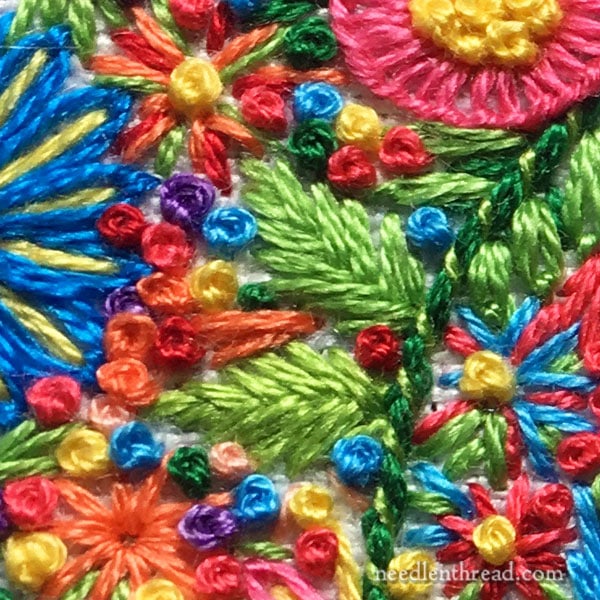
In the photo above, which is a close-up on this voided monogram hat I showed you the other day and since finished, the green two-leaf cluster in the middle of the photo features fishbone stitch.
Whether you’re working tiny leaves or petal shapes, or even larger shapes (you’ll find an example below), fishbone stitch fills a shape so that a small overlap forms down the middle of the shape, naturally creating a vein or line where the overlap happens. This is what makes it just perfect for leaves and petals.
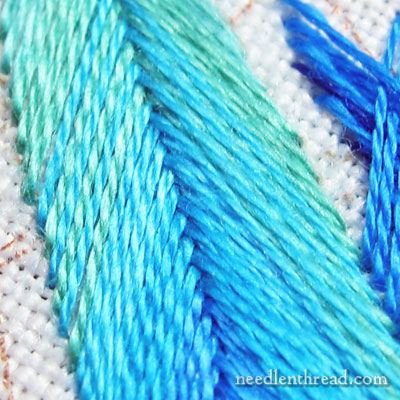
The fishbone stitch works well for filling larger but narrow shapes, too. Think: feathers! The photo above is a feather in fishbone stitch, from my project Secret Garden Hummingbirds, which you can find detailed step-by-step here.
In the article that focuses on the fishbone stitch feathers, I discuss how to shade fishbone stitch using multiple colors of threads as you fill the shape.
So, fishbone stitch not only works well for a filling, but it can also be shaded with a realistic, gradual shading. And that’s a nice little bonus for a nice little stitch!
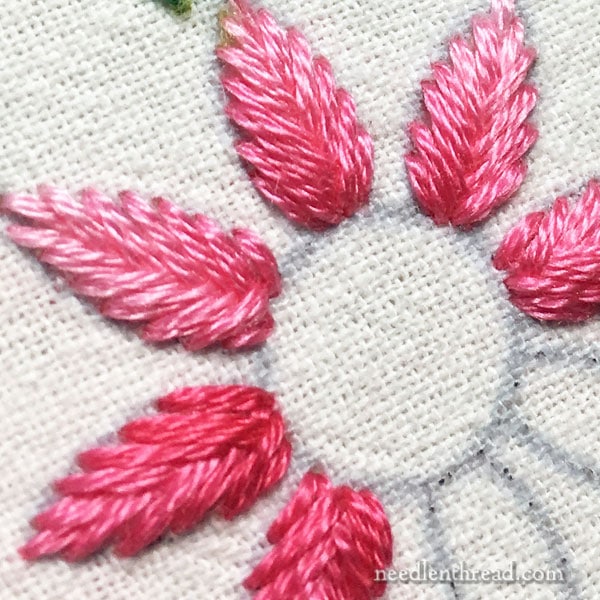
In the shading tutorial with the feather, the color changes were accomplished by switching out thread colors gradually. And that works, but, for small filled elements – like the little flower petals in the photo above – switching to new threads might be a bit tedious.
And this is where variegated threads come in handy. If you want a shaded effect with fishbone stitch, but you’re filling relatively small shapes and don’t want to deal with switching out to new thread colors while you’re stitching, try using variegated threads instead!
If you cut the variegated thread so that the cut includes a short section of light turning to dark in the variegation, as you fill the shape, you’ll see a gradual changing of shade from tip to base. This is why the pink petals above are not one solid color, but rather lighter on the tips and darker at the base.
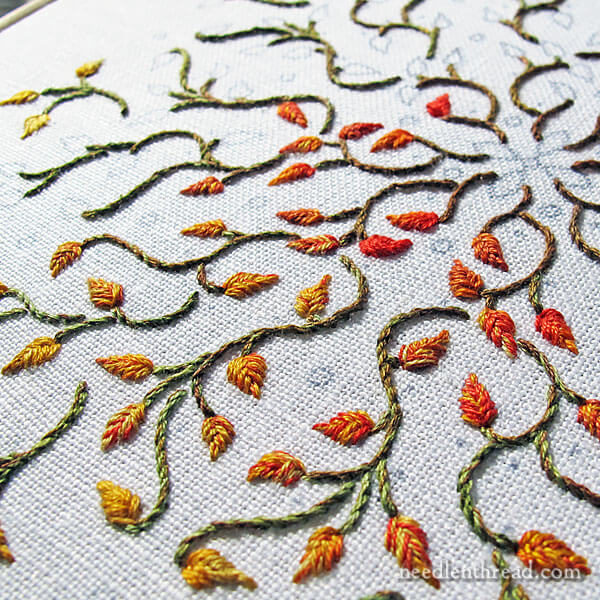
The tiny leaves in this photo are also fishbone stitch.
We talked about these particular leaves (and traveling threads from leaf to leaf) in this article, here.
The shading on the leaves from Octoberfest! is accomplished by using overdyed threads and mixing the colors in the needle.
So that’s another way you can shade fishbone stitch – working with two colors in the needle at once, especially with overdyed or variegated threads that will give you color change as you stitch.
It’s a Quick Filling!
Perhaps one of the main reasons I love fishbone stitch so much is that it is a really quick filling that gives very satisfactory results.
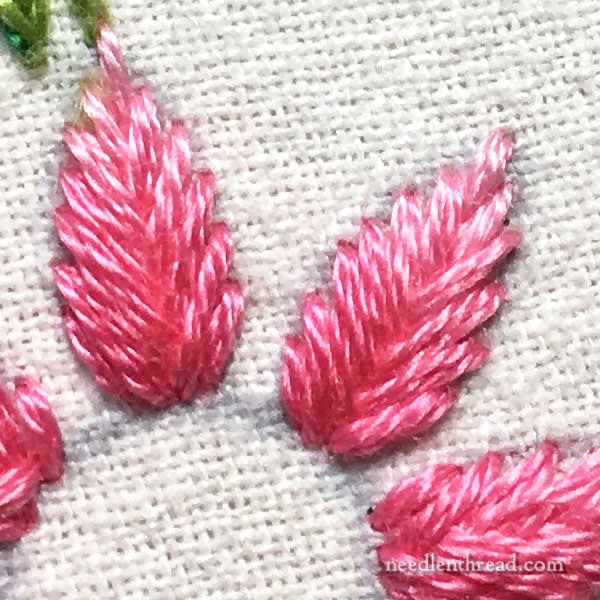
Take the pink petals as an example. If I had filled those with padded stem stitch or long and short stitch shading, each petal would have taken quite a while to stitch.
But with fishbone stitch, and using three strands of floss in the needle, each petal shape took only about 13-14 straight stitches to fill the shape.
Fishbone stitch works up quickly, so that, in no time flat, you’ve got a satisfactorily filled little shape emerging on your cloth.
Gosh, I love this stitch!
Learn the Fishbone Stitch
You can learn the fishbone stitch by watching my fishbone stitch video tutorial here.
And you can find a video for a variation called the raised fishbone stitch here. This variation will give you a fuller shape that sits up a bit more off the fabric, in case you want some extra dimension to your leaf. It uses up slightly more thread, but it’s a fun variation!
You can also find fishbone stitch in pretty much any good stitch dictionary. If you don’t have a stitch dictionary yet, I encourage you to get one! It’s always handy to have a real book you can pick up or tote with you, to use as a reference when you’re learning new stitches.
I’ve got a slew of stitch dictionaries reviewed here on Needle ‘n Thread and listed on my Book Index page.
And you can find some of the best ones listed right at the top of my Amazon page here.
Over to You
So, what about you? Would you list fishbone stitch among your Absolute Favorite Stitches? Do you have another stitch for leaf or petal fillings that you turn to repeatedly? I’d love to hear your input, and your questions and comments can help other stitchers learn more about embroidery, too.
Feel free to chime in below!
This post contains an affiliate link to my Amazon page, which means Needle ‘n Thread receives a small kickback for any Amazon purchase made through that link, without any extra cost to you.







I love the Fishbone stitch–for all the reasons you mentioned, but also because it’s easy to learn. I don’t forget how to do it in between uses. I also use stem stitch a lot. I once used backstitch to do redwork, but have switched to stem stitch because it’s faster and leaves a neater line. Blanket stitch and buttonhole stitch come in handy for wool applique and surface embroidery, while I use French knots a lot more than I used to since I learned what I was doing wrong through your tutorial video.Your video library is bookmarked and referred to often!
Stem stitch is a huge favorite of mine, too!
Good morning Mary
Yes, the fishbone stitch is on my favourite list. My favourite is stem – it does many, many things – and second would be French knot.
I like your connect to Amazon.
Sharon
Dear Mary
I really like the fishbone stitch after recently embroidering some leaves and realised it’s such an easy stitch, I agree with you for all the reasons you have given above. It’s an easy stitch and quick, it’s looks so pretty and with variegated thread it leaves a lovely colourful design. I also like and consider the buttonhole stitch as one of my favourites as I find this an easy and attractive stitch. Thanks for your views on your favourite stitches and for sharing with us and for the links above on one of your favourite stitches the fishbone stitch.
Regards Anita Simmance
I do like the fishbone, but nothing beats the good old stem stitch for me.
I don’t stitch for too long yet, and by now my AFS (Absolute Favourite Stitch) ist Stem Stitch, because it looks always nice and is incredibly versatile. Also French Knot, Ribbed Spider Web, Backstitch … Portuguese Knotted Stem Stitch! … and I really loved doing Woven Picots, Woven Wheels and Granitos. But if I had a leave to do … ahem… I think I would prefer Stem Stitch … I admit that I didn’t manage a perfect Fishbone Stitch yet … and the reason is: I’m unable to keep the angle straight! How do you all do that?
Angela from the Ore Mountain
I think it’s probably just a matter of practicing it a bit, Angela. You can always pull your working thread in the direction you want to take the stitch and see where it will fall best, before inserting the needle. After a while, though, it will become second nature!
The fishbone stitch is perfect for a project I’m about to start. It is a sampler from “Follow The White Bunny” that I fell in love with and the fishbone stitch will be perfect for the flowers. Many thanks for the reminder of this terrific stitch.
I love everything you do! I’ve been a fan for about 5 years.
In my head I compose comments, compliments, congratulations and rah-rahs (like a cheerleader) to you. Not sure why I don’t let you hear it oftener . I love your new “place”. I want to sit in those upholstered chairs in front of those Jacobean curtains! I admire you teaching youth. I started 4-H in grade 3 or 4 and so began my affair with all things involving needle and thread! Again, I greatly applaud your involvement in our future like that!!
You have the best how-to videos by far and I share your name often. Thank you for doing “that voodoo that you do so well” (ha, just had to say it!). When you write something or use the spoken word I feel like I’m next to you and you’re talking to me. I’m sure everyone feels the same.
Your [not-very-humble] fan ~Judy
Thanks, Judy! 🙂
I LOVE all your work and inspiration. At our smocking guild meeting the other evening we tried to figure out just how you get so much done all the time!! We’re all quite good at the crunch projects but can’t seem to get as many beautiful, creative things done as you do on a regular basis and your wonderful newsletter
. Well done!, we say! And thank you for all the beauty and knowledge you share.
I like the fish bone stitch and use often. The stitch that haunts me is the lazy daisy. If it’s small it seems ok but when I try to enlarge it for some motifs it collapses when washed. So I attempt to replace it with other stitches. I have not as yet been satisfied. Maryann
Yes, daisy stitch doesn’t work so well when the stitches are long and the item is meant to be washed. Maybe try granitos? They’re easy and they work up into pretty petals! https://needlenthread.wpengine.com/2012/07/granitos-in-embroidery-video-tutorial.html
I’m going to swim against the tide here… I use all the usual ones like stem, outline, buttonhole, french knots and, yes, fishbone for all the reasons you give and illustrate so beautifully. But often my go-to stitch when I’m in a fankle is some form of herringbone stitch. Well, it’s a kind of fish, isn’t it? I love the way it changes depending on how snugly you do the stitching. You can whip it, you can bead it, you can fill in the spaces. Herringbone for me. 🙂
I’ve been teaching some of the ladies in my embroidery classes fishbone stitch. We really like it! I wouldn’t say it is amongst my favourite stitches though. They would probably be palestrina stitch and cable plait stitch. Palestrina is great for outlining leaves, and you can use it as a filling stitch too. Cable plait isn’t a filling stitch, but again, is useful for outlining leaves.
If you need instructions for these stitches, you can find them in my stitch dictionaries: The Left-Handed Embroiderer’s Companion and The Right-Handed Embroiderer’s Companion. 😉
Hi I have been stitching the wishbone stitch and it is very nice. However on the pattern I. have there are gaps on the side which I think is too small for this stitch an I maybe do Satin stitch on these places and maybe use a variegated thread.
I look forward to hearing from you. Kind regards.j. howells
Sounds like a good idea, Jean! Just fill where you need to.